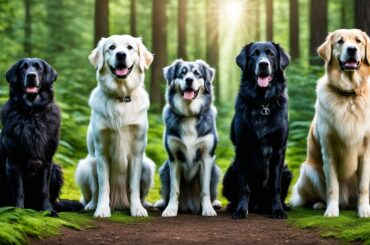When it comes to choosing the perfect dog breed, Dobermans and German Shepherds often top the list. These two breeds are known for their intelligence, loyalty, and versatility. However, they also have distinct differences that can influence which breed is the right fit for you. In this ultimate breed comparison, I will explore the unique characteristics of Dobermans and German Shepherds, including their temperament, intelligence, trainability, exercise needs, size, and their roles as guard dog breeds.
Key Takeaways:
- Dobermans and German Shepherds are both intelligent and loyal dog breeds.
- German Shepherds are generally less aggressive, while Dobermans can display more aggression.
- Both breeds require regular exercise, but Dobermans are more adaptable to smaller living spaces.
- German Shepherds are versatile in various disciplines of training, while Dobermans require firm and consistent training.
- With proper socialization and training, both breeds can be great companions for families.
Temperaments: A Closer Look at the Personalities
When comparing the temperaments of Doberman Pinschers and German Shepherds, you should understand their unique personalities and tendencies. German Shepherds are known for their strong desire to please their owners and their natural herding instincts. This breed is generally less aggressive and more protective than Dobermans.
On the other hand, Dobermans are often described as more aloof and may exhibit a higher level of aggression, especially when they perceive a threat towards their owners. Early socialization and consistent obedience training are crucial for both breeds to develop a well-rounded temperament and keep any aggressive tendencies in check.
German Shepherds are loyal and intelligent dogs that thrive on building strong bonds with their owners. They are easily trainable and can excel in various disciplines. Dobermans, on the other hand, have a curious and clever nature, which requires firm and consistent training from all family members. You should establish boundaries and prevent any behavioral issues from arising.
Both breeds have their own unique set of temperament characteristics, and it is essential to consider these when deciding which breed is the right fit for your lifestyle and family dynamics.
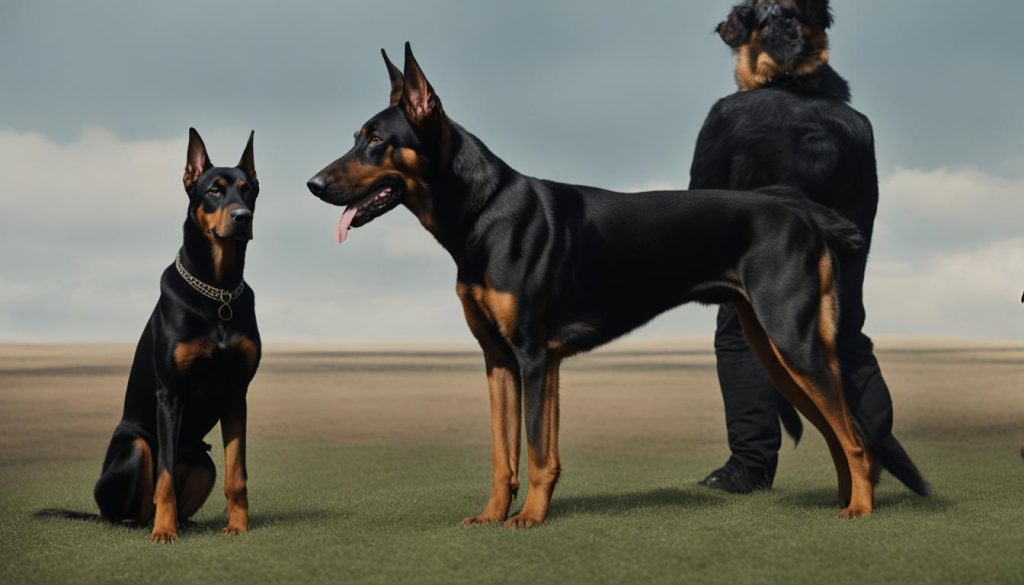
| Temperament Traits | Doberman Pinscher | German Shepherd |
|---|---|---|
| Aggression | May display more aggression, especially when they perceive a threat towards their owners | Generally less aggressive, but can be protective |
| Socialization | Early socialization is crucial to prevent aggression and develop a well-rounded temperament | Also requires early socialization to ensure proper behavior with other animals and people |
| Obedience Training | Requires firm and consistent training from all family members to establish boundaries and prevent behavioral issues | Easily trainable and excels in various disciplines |
Exercise Needs: Keeping Active and Fit
When it comes to exercise needs, both Dobermans and German Shepherds are energetic breeds that require regular physical activity to stay happy and healthy. Daily walks and mental exercise are essential to meet their exercise requirements and prevent boredom and destructive behaviors.
German Shepherds are known for their high energy levels and need for physical stimulation. They thrive in large outdoor spaces where they can run, play, and explore. Regular exercise not only keeps them physically fit but also helps to channel their energy in a positive way. In addition to daily walks, providing them with mental stimulation through obedience training and interactive games can help keep their minds sharp.
Dobermans, while also requiring daily exercise, are more adaptable to smaller living spaces like apartments. They are highly intelligent and benefit from mental stimulation as much as physical activity. Regular walks combined with obedience training, puzzle toys, and interactive play sessions can help keep them mentally and physically stimulated.
Apartment Living and Exercise Alternatives
Apartment living can present challenges when it comes to providing ample exercise for high-energy breeds like Dobermans and German Shepherds. However, with proper planning and creativity, they can still thrive in smaller spaces.
- Designated exercise areas: Create a designated space in your apartment for exercise, such as a corner for indoor fetch or a mini agility course using portable obstacles.
- Interactive toys: Invest in interactive toys that require mental and physical effort to engage with, such as treat-dispensing puzzles.
- Doggy daycare or playdates: Consider enrolling your dog in a reputable doggy daycare a few times a week or arranging playdates with other friendly dogs to provide social interaction and exercise.
To put it simply, regardless of living situation, provide regular exercise and mental stimulation to keep Dobermans and German Shepherds happy and balanced.
| Doberman Exercise Needs | German Shepherd Exercise Needs | |
|---|---|---|
| Physical Activity | Require daily exercise to release energy and prevent boredom. Adaptable to smaller living spaces like apartments. | High energy levels and need for physical stimulation. Thrive in large outdoor spaces where they can run and play. |
| Mental Stimulation | Highly intelligent and benefit from mental exercise. Regular obedience training and interactive play sessions are important. | Benefit from mental stimulation as much as physical activity. Regular obedience training and interactive games are crucial. |
| Exercise Alternatives | Indoor fetch, mini agility courses, interactive toys, doggy daycare, and playdates can help meet exercise needs in apartment living. | Outdoor play, regular walks, mental stimulation through obedience training, and interactive toys are essential. |
Training: Harnessing their Intelligence
When it comes to training, both Dobermans and German Shepherds showcase their exceptional intelligence. However, their approach to training differs due to their unique temperaments and characteristics.
German Shepherds are renowned for their versatility and trainability in various disciplines such as competition, herding, and protection work. Their eagerness to please their owners and their natural herding instincts make them quick learners. Early socialization and exposure to different people and situations are crucial for German Shepherds to develop a well-rounded and obedient nature.
Dobermans, on the other hand, possess curious minds and cleverness that can make training more challenging. They require firm and consistent training from all family members to establish boundaries and prevent any behavioral issues. A comprehensive training program that focuses on building trust and providing mental stimulation is essential for harnessing their intelligence. Early socialization is particularly important for Dobermans to instill good behavior and prevent any aggression tendencies.
Training Tips:
- Start training early: Both breeds benefit from early socialization and obedience training to shape their behavior from an early age.
- Be firm and consistent: Establish clear rules and boundaries to ensure they understand their place within the family hierarchy.
- Use positive reinforcement: Reward-based training techniques, such as treats and praise, can motivate and encourage good behavior.
- Provide mental stimulation: Both breeds have high intelligence levels and require mental challenges to prevent boredom and destructive behavior. Puzzle toys and obedience training sessions can help keep their minds engaged.
- Seek professional help if needed: If you encounter difficulties during the training process, don’t hesitate to seek guidance from a professional dog trainer. They can provide valuable insights and techniques specific to your breed.
By understanding their different training needs and employing appropriate techniques, both Dobermans and German Shepherds can thrive in a structured and disciplined environment.
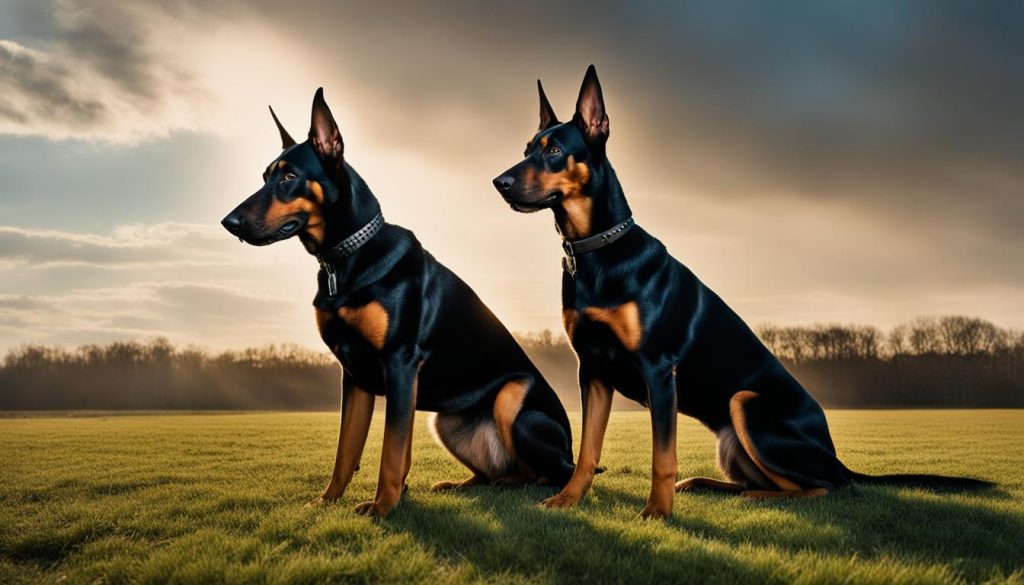
With Children: Family Compatibility
When considering a new furry addition to the family, evaluate how a particular breed will interact with children. Both German Shepherds and Dobermans have the potential to be great family pets, but proper socialization and training are key factors in ensuring compatibility.
German Shepherds, when properly trained and socialized from a young age, are known for their devotion and love towards their families. They can be gentle and patient with children, making them great companions. However, I would advise that you teach children how to interact appropriately with the dog and establish clear boundaries to ensure a harmonious relationship.
Similarly, Dobermans can also be excellent with children when provided with consistent training and early socialization. However, due to their protective nature, please closely monitor interactions and prevent any signs of aggression. Proper socialization and firm training from an early age are necessary to ensure they behave appropriately around kids.

Overall, the compatibility between German Shepherds and Dobermans with children depends on responsible ownership, proper training, and socialization. With the right approach, both breeds can form strong bonds and provide a loving and protective presence within the family.
Shedding: Coat Maintenance
Proper coat maintenance is an essential aspect of caring for both German Shepherds and Dobermans. Understanding their shedding patterns and grooming needs can help keep their coats healthy and presentable.
German Shepherds have a thick, double-layered coat that requires regular brushing and occasional bathing. They are moderate shedders, especially during shedding seasons, and may require more grooming to keep their coats in good condition. Regular brushing helps remove loose hair, prevents matting, and promotes healthy skin and coat. Occasional bathing with a suitable dog shampoo helps keep their coat clean and free of dirt and debris.
On the other hand, Dobermans have a sleek and thin coat that sheds less compared to German Shepherds. They are considered low-maintenance when it comes to grooming and require minimal brushing. However, regular brushing is still beneficial as it helps distribute natural oils, remove loose hair, and maintain a healthy coat. Dobermans do not require frequent bathing unless they get excessively dirty or have a specific skin condition.
| Breed | Shedding Level | Grooming Needs |
|---|---|---|
| German Shepherd | Moderate | Regular brushing, occasional bathing |
| Doberman | Low | Minimal brushing, occasional bathing |
I recommend that you remember that shedding can vary among individual dogs, and factors such as diet, overall health, and environmental conditions can also affect the amount of shedding. Regular grooming sessions not only help maintain their coat’s health but also provide an opportunity to check for any skin issues, parasites, or abnormalities that may require further attention.
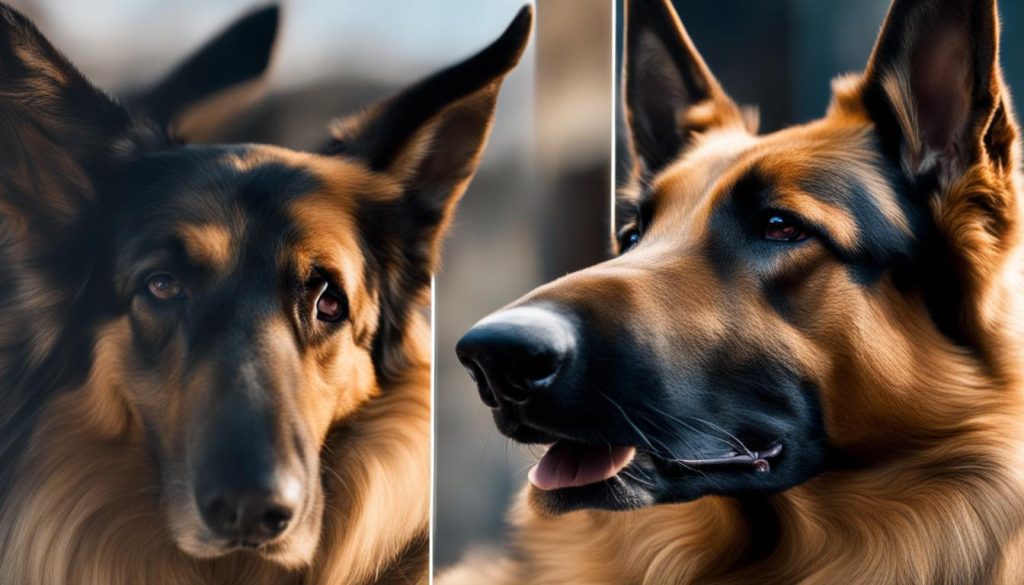
Size Comparison: A Closer Look at the Numbers
When considering the size of Doberman Pinschers and German Shepherds, there are slight differences between the two breeds. Dobermans are generally slightly taller than German Shepherds, measuring between 26-28 inches at the shoulder compared to the German Shepherd’s height range of 24-26 inches. In terms of weight, Dobermans also tend to be heavier, typically ranging from 60-100 pounds, while German Shepherds weigh between 50-90 pounds.
To provide a visual representation of the size differences, here is a comparison table:
| Breed | Height (inches) | Weight (pounds) |
|---|---|---|
| Doberman Pinscher | 26-28 | 60-100 |
| German Shepherd | 24-26 | 50-90 |
As seen in the table, Dobermans generally have a slightly greater size compared to German Shepherds. However, individual variations within each breed can occur, and these ranges serve as an average guideline.
Considerations for Size
When deciding between a Doberman and a German Shepherd, please consider your living situation, available space, and your ability to meet the exercise needs of a larger breed. Dobermans, being slightly taller and heavier, may require more room to move around and exercise, while German Shepherds can adapt well to different living environments.
the size difference between Dobermans and German Shepherds should not be the sole factor in choosing a breed. Temperament, exercise needs, and compatibility with your lifestyle should also be taken into account. Consulting with reputable breeders or experienced dog owners can provide valuable insights into the specific needs and characteristics of each breed.

To put it simply, regardless of their size, both Dobermans and German Shepherds require responsible ownership, proper training, and socialization to ensure they become well-rounded and loving companions.
Breed History: Origins and Purpose
The history of the German Shepherd and Doberman breeds is rooted in their origins and purpose. Both breeds were developed for specific roles and possess unique characteristics that reflect their working dog heritage. Understanding their breed history provides valuable insight into their temperament, trainability, and suitability for various tasks.
German Shepherd Breed History
The German Shepherd breed originated in Germany in the late 19th century. They were created by Captain Max von Stephanitz, who aimed to develop a versatile herding dog capable of assisting farmers with their livestock. Through selective breeding, he combined various local herding dogs to create a breed that possessed the desired traits of intelligence, agility, and loyalty. German Shepherds quickly gained recognition for their exceptional working abilities and soon expanded beyond their original purpose as herding dogs.
The German Shepherd breed history emphasizes their adaptability and intelligence, making them suitable for a wide range of tasks, including search and rescue, police and military work, and service dog roles. Their hard-working nature and unwavering loyalty have made them a popular choice among dog enthusiasts worldwide.
Doberman Breed History
The Doberman breed has a more recent origin, dating back to the late 19th century in Germany. They were developed by a tax collector named Karl Friedrich Louis Dobermann, who desired a loyal and protective companion to accompany him during his tax collection duties. To achieve this, he selectively bred several breeds, including the Rottweiler, German Pinscher, and Greyhound. The resulting breed, known as the Doberman Pinscher, possessed the ideal combination of power, endurance, and loyalty.
The Doberman breed history highlights their original purpose as guard dogs, showcasing their protective instincts and natural ability to deter potential threats. Today, Dobermans are cherished for their intelligence, agility, and unwavering loyalty to their families.
| Breed | German Shepherd | Doberman |
|---|---|---|
| Origin | Germany | Germany |
| Original Purpose | Herding | Guarding and protection |
| Key Traits | Intelligence, loyalty, versatility | Power, endurance, loyalty |
| Working Abilities | Search and rescue, police and military work, service dogs | Guarding, protection, family companionship |
Understanding the breed history of German Shepherds and Dobermans sheds light on their working dog heritage and the traits that make them unique. While German Shepherds excelled as versatile herding dogs and expanded into various working roles, Dobermans were developed specifically for guarding and protection. These breed histories provide a foundation for appreciating their distinct qualities and can help guide individuals in finding the right breed for their specific needs and lifestyle.
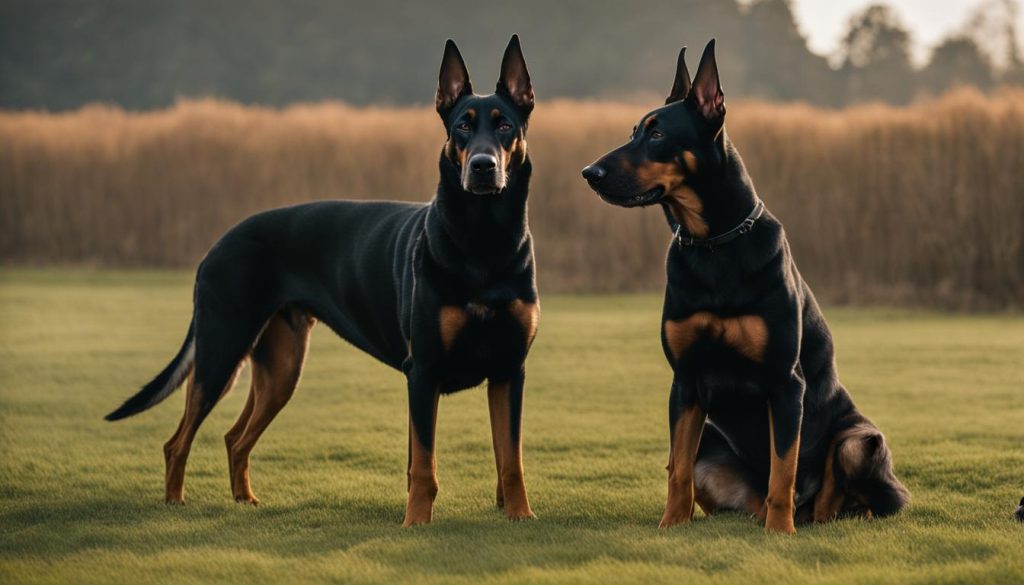
Final Thoughts: Finding the Right Breed for You
After exploring the various aspects of Dobermans and German Shepherds, it is clear that both breeds have their own unique strengths and characteristics. The choice between the two ultimately depends on your lifestyle, living situation, and commitment to training. You should consider these factors carefully to ensure that you choose the breed that is the best fit for you and your family.
German Shepherds are versatile and loyal companions, well-suited for active families with a large yard. They thrive on physical activity and mental stimulation, making them an excellent choice for those who enjoy outdoor activities and are committed to providing proper training and socialization. On the other hand, Dobermans are adaptable to apartment living and can be a great companion for individuals or families in smaller spaces. Although they also require regular exercise and mental stimulation, Dobermans offer a more manageable size and can be a suitable choice for those with a more confined living environment.
You should note that both breeds require responsible ownership and a commitment to training and socialization. Proper training from an early age is essential to ensure that both Dobermans and German Shepherds behave appropriately around children and other animals. Additionally, both breeds benefit from regular grooming to keep their coats healthy and free from matting or tangles.
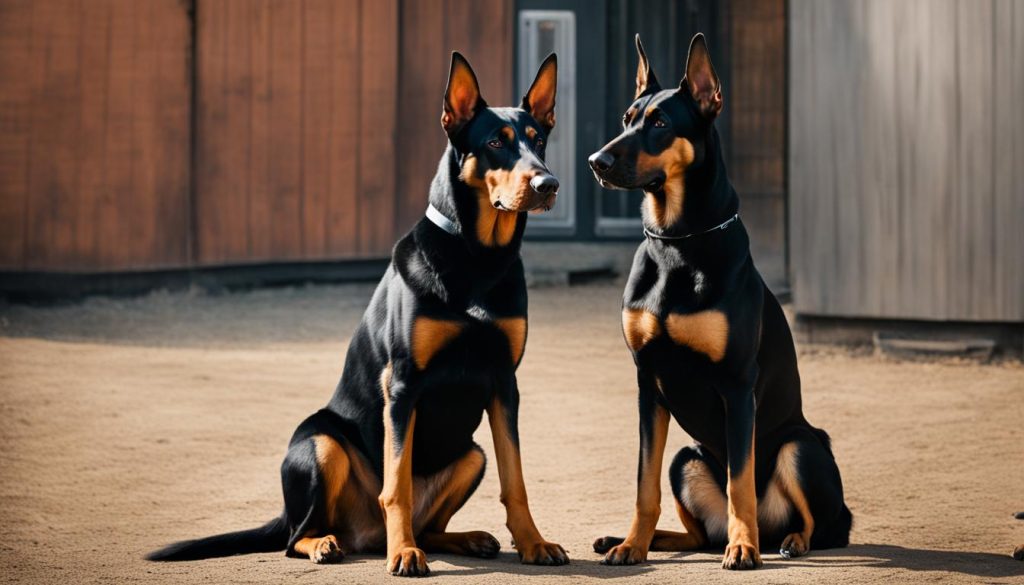
When making a decision between Dobermans and German Shepherds, it is good practice to consider your preferences, available space, and commitment to training. Researching breed-specific clubs and organizations can provide valuable information and support for responsible dog ownership. Consulting reputable sources and experts in the field will help you gather accurate and reliable information to aid in your decision-making process.
Resources:
When it comes to gathering information about Dobermans and German Shepherds, there are plenty of resources available to help you make an informed decision about these breeds. Whether you’re a potential owner looking for more information or a current owner seeking support and guidance, these resources can be valuable tools in your journey.
Breed Information:
One of the first steps in learning about a specific breed is to access reliable and detailed breed information. The American Kennel Club (AKC) and The Kennel Club (UK) are reputable sources that provide comprehensive breed profiles, highlighting the characteristics, history, and care requirements for Dobermans and German Shepherds. Additionally, reputable dog breeders and breed-specific websites can offer valuable insights into these breeds’ traits, temperaments, and health considerations.
Breed Clubs and Organizations:
Breed clubs and organizations dedicated to Dobermans and German Shepherds can provide a wealth of resources and support. The Doberman Pinscher Club of America and the German Shepherd Dog Club of America are prime examples of reputable clubs that promote responsible ownership and provide guidance on various aspects of these breeds, including health, training, and breed-specific activities. These clubs often host events, training seminars, and competitions where you can connect with experienced breed enthusiasts and professionals.
Training Resources:
Proper training is essential for ensuring that your Doberman or German Shepherd becomes a well-behaved and obedient companion. There are numerous resources available to assist you in training your dog, from books and online courses to professional trainers who specialize in working with these breeds. The AKC and other reputable dog training organizations offer a range of resources, including training guides, articles, and videos, that can help you develop effective training techniques and address specific behavioral issues.
Final Thoughts:
With a wide range of resources available, you can confidently navigate the world of Dobermans and German Shepherds. By accessing reliable breed information, connecting with breed clubs and organizations, and utilizing training resources, you can make informed decisions, provide proper care, and develop a strong bond with your canine companion.
| Resource | Description |
|---|---|
| American Kennel Club (AKC) | Official website providing detailed breed profiles and information on responsible dog ownership. |
| The Kennel Club (UK) | Reputable organization offering comprehensive breed information and resources for dog owners in the United Kingdom. |
| Doberman Pinscher Club of America | Breed club dedicated to promoting responsible Doberman ownership and providing support and resources to Doberman enthusiasts. |
| German Shepherd Dog Club of America | Organized group that supports German Shepherd owners and provides information on the breed’s care, training, and events. |
| AKC Training Resources | Training guides, articles, and videos offered by the AKC to help dog owners effectively train their Dobermans and German Shepherds. |
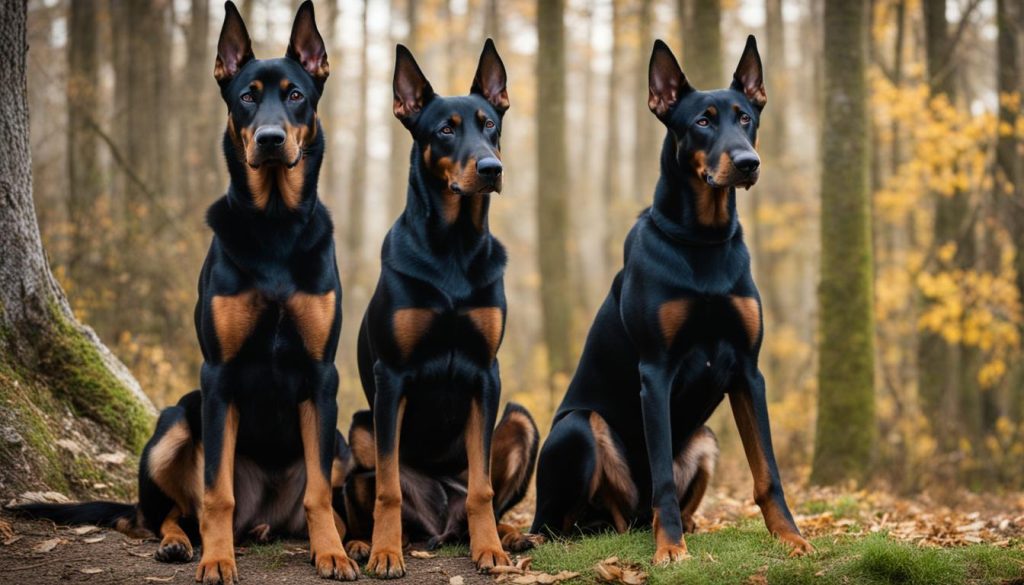
Final Thoughts:
After comparing the Doberman and German Shepherd breeds, it is clear that they have distinct differences that make them suitable for different lifestyles and living situations. German Shepherds are versatile, loyal, and thrive in homes with large yards and active families. Their intelligence and herding instincts make them excellent companions for those who enjoy outdoor activities and have the space to accommodate their energy needs.
On the other hand, Dobermans are adaptable to apartment living and can thrive with regular exercise and mental stimulation. Their sleek and thin coat, along with their lower shedding tendencies, make them low-maintenance in terms of grooming. They are known for their intelligence and can excel with consistent training and socialization.
When deciding between the two breeds, consider your own lifestyle, living situation, and commitment to training. Both the Doberman and German Shepherd require responsible ownership and a dedication to meeting their specific needs. Whether you choose a German Shepherd or a Doberman, remember that training, socialization, and providing a loving and stimulating environment are key to raising a well-rounded and happy companion.
FAQ
What are the key differences in temperament between Doberman Pinschers and German Shepherds?
German Shepherds have a strong drive to please and natural herding instincts, while Dobermans tend to be more aloof and can display more aggression when they perceive a threat towards their owners.
How much exercise do Dobermans and German Shepherds need?
Both breeds require regular exercise, but German Shepherds thrive in large outdoor spaces where they can run and play, while Dobermans are more adaptable to smaller living spaces like apartments.
How trainable are Dobermans and German Shepherds?
Both breeds are highly intelligent and trainable, but German Shepherds are known for their versatility and trainability in various disciplines, while Dobermans can be more challenging to train due to their cleverness.
Are Dobermans and German Shepherds good with children?
When properly trained and socialized, both breeds can be great with children. However, you should establish leadership within the household and closely monitor interactions to prevent any aggressive behavior.
What are the grooming needs of Dobermans and German Shepherds?
German Shepherds have a thick, double-layered coat that requires regular brushing and occasional bathing. Dobermans have a sleek and thin coat that sheds less and requires minimal brushing.
How do the sizes of Dobermans and German Shepherds compare?
Dobermans are slightly taller, measuring 26-28 inches at the shoulder, compared to German Shepherds, which stand at 24-26 inches. Dobermans are also generally heavier, ranging from 60-100 pounds, while German Shepherds weigh between 50-90 pounds.
What is the history and purpose behind Dobermans and German Shepherds?
German Shepherds were developed as herding dogs in Germany, known for their intelligence and versatility. Dobermans were originally bred as guard dogs by a tax collector and were meant to provide protection during tax collection activities.
How can I determine which breed is right for me?
Choosing between a Doberman and a German Shepherd depends on your lifestyle, living situation, and commitment to training. Consider your preferences, available space, and the specific needs of each breed to make an informed decision.
Where can I find more information about Dobermans and German Shepherds?
Breed-specific clubs, organizations, and training resources provide valuable information and support for responsible dog ownership. Consult reputable sources and experts in the field for accurate and reliable information.




